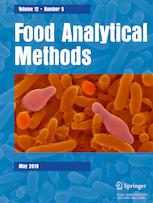Ver ítem
- xmlui.general.dspace_homeCentros e Institutos de InvestigaciónCIA. Centro de Investigaciones de AgroindustriaInstituto de Tecnología de AlimentosArtículos científicosxmlui.ArtifactBrowser.ItemViewer.trail
- Inicio
- Centros e Institutos de Investigación
- CIA. Centro de Investigaciones de Agroindustria
- Instituto de Tecnología de Alimentos
- Artículos científicos
- Ver ítem
Effect of processing on the detectability of pecan proteins assessed by immunological and proteomic tools
Resumen
The present study evaluates the effect of food processing on the antigenicity of pecan proteins as measured by enzyme-linked immunosorbent assay (ELISA). In addition, proteomic tools were used to identify potential pecan markers suitable for confirming the presence of pecan proteins in food and validating new methods developed to detect traces of the commodity. To assess the effects of processing on protein stability and antigenicity, pecan nuts were
[ver mas...]
The present study evaluates the effect of food processing on the antigenicity of pecan proteins as measured by enzyme-linked immunosorbent assay (ELISA). In addition, proteomic tools were used to identify potential pecan markers suitable for confirming the presence of pecan proteins in food and validating new methods developed to detect traces of the commodity. To assess the effects of processing on protein stability and antigenicity, pecan nuts were submitted to heat treatments and extracts were analysed by ELISA, sodium dodecyl sulphate polyacrylamide gel electrophoresis and Western blot. The ELISA method was able to detect pecan traces even after submitting the commodity to
rigorous treatments, though these treatments affected the detectability to varying degrees. Proteomic assessment showed that the majority of pecan proteins were matched by homology to walnut proteins, which are more abundantly populated in the protein sequence databases. However, there
were a few important exceptions: 7S vicilin, 11S legumin and putative allergen I1, unambiguously identified as pecan in origin. Interestingly, putative allergen I1 offered unique analytical advantages to be used as a pecan marker for validation and confirmation purposes.
[Cerrar]

Autor
Polenta, Gustavo Alberto;
Weber, Dorcas;
Godefroy Benrejeb, Samuel;
Abbott, Michael;
Fuente
Food analytical methods 5 (2) : 216–225. (April 2012)
Fecha
2011-05-19
Editorial
Springer
ISSN
1936-9751
1936-976X (Online)
1936-976X (Online)
Formato
pdf
Tipo de documento
artículo
Palabras Claves
Derechos de acceso
Restringido
 Excepto donde se diga explicitamente, este item se publica bajo la siguiente descripción: Creative Commons Attribution-NonCommercial-ShareAlike 2.5 Unported (CC BY-NC-SA 2.5)
Excepto donde se diga explicitamente, este item se publica bajo la siguiente descripción: Creative Commons Attribution-NonCommercial-ShareAlike 2.5 Unported (CC BY-NC-SA 2.5)

